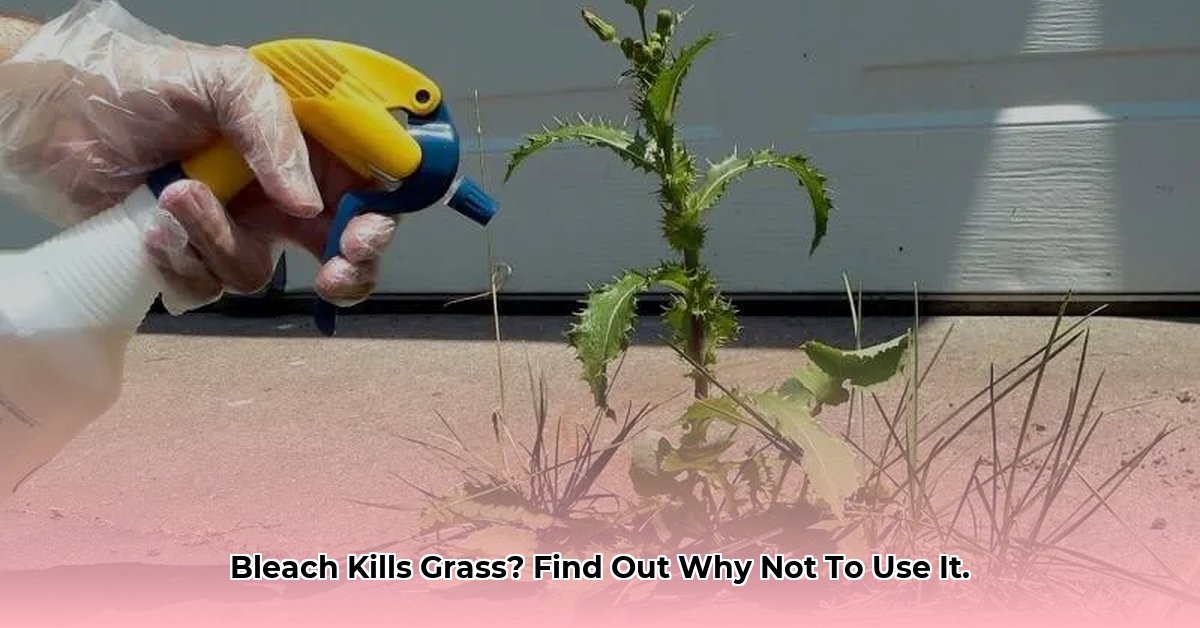Bleach does kill grass. But before you reach for that bottle, consider this: using bleach is like using a nuclear bomb to deal with an ant hill. Effective? Yes. Overkill with potentially disastrous consequences? Absolutely. This guide explores the science behind bleach’s herbicidal action, the risks involved, and—most importantly—safer, more sustainable alternatives.
Understanding Bleach’s Impact
Bleach, chemically known as sodium hypochlorite, decimates plant cells. It disrupts photosynthesis by dismantling chlorophyll, the green pigment essential for plants to convert sunlight into energy. Essentially, bleach starves the plant. It also attacks cell walls, causing them to collapse. The severity of damage depends on the bleach concentration, the amount applied, and the duration of exposure. A splash may cause discoloration; a concentrated dose can obliterate a plant.
Beyond the visible damage, bleach wreaks havoc on soil health. It decimates beneficial microorganisms crucial for nutrient cycling and soil structure. It also disrupts the soil’s pH balance, creating an inhospitable environment for plants. The chloride ions in bleach can accumulate, potentially poisoning the soil and hindering future growth.
Using Bleach: A Last Resort (Seriously!)
If you’ve exhausted every other option and still believe bleach is necessary (and we implore you to reconsider), proceed with extreme caution:
- Gear Up: Protect yourself with thick rubber gloves, eye protection (goggles are ideal), and a mask to prevent fume inhalation.
- Dilute Extensively: Mix one part bleach with ten parts water (or even more). A weaker solution is often sufficient and less harmful.
- Targeted Application: Carefully apply the diluted solution only to the unwanted grass, minimizing overspray. Avoid contact with desirable plants and be mindful of wind conditions.
- Post-Application Rinse: Thoroughly water the treated area to dilute remaining bleach and lessen soil impact.
The Dangers of Bleach
Bleach is an environmental hazard. Runoff can contaminate water sources, harming aquatic life. It poses risks to pets and children who may come into contact with treated areas. Some research suggests that chlorine, a key component of bleach, can persist in the environment, contributing to long-term ecological damage.
Greener Alternatives
Fortunately, numerous safer and more sustainable methods exist for grass removal:
- Manual Removal: For small patches, pulling weeds by hand is the most eco-friendly option.
- Boiling Water: Effective for weeds sprouting through cracks or small areas. The heat scalds and kills the plants.
- Solarization: Cover the area with clear plastic sheeting for several weeks. The trapped heat bakes the grass and weeds. This method is best suited for larger areas and requires sunny weather.
- Vinegar: Horticultural vinegar offers a less harsh, readily available alternative. However, it may require repeat applications and can affect surrounding plants.
- Natural Herbicides: Several commercially available herbicides utilize natural ingredients and are designed to biodegrade, minimizing environmental impact. Always choose products appropriate for your specific needs and carefully follow label instructions.
- Corn Gluten Meal: A natural pre-emergent herbicide that prevents weed seeds from sprouting. It’s effective for preventing future growth but won’t kill established weeds. Use caution as it can also prevent desired seedlings from growing.
| Method | Pros | Cons |
|---|---|---|
| Manual Removal | Environmentally friendly, precise control | Labor-intensive, not practical for large areas |
| Boiling Water | Simple, readily available, inexpensive, quick | Limited effectiveness for larger areas or deeply rooted weeds |
| Solarization | Eco-friendly, inexpensive, covers larger areas | Time-consuming (weeks), requires consistent sun exposure |
| Vinegar | Natural, readily available | Less effective than commercial herbicides, may require repeated applications, can harm surrounding plants |
| Natural Herbicides | Targeted weed control, biodegradable options available | Can be more expensive, varying effectiveness |
| Corn Gluten Meal | Prevents weed seeds from sprouting (pre-emergent) | Not effective on established weeds |
Restoring Bleach-Damaged Soil
If bleach has already been used, mitigate the damage by:
- Flush the Area: Water thoroughly to dilute and leach remaining bleach.
- Amend the Soil: Incorporate compost or other organic matter to replenish lost nutrients and beneficial microbes.
- Aerate (If Necessary): Improve drainage and oxygen flow to aid recovery.
Full recovery takes time, but these steps can help revitalize the soil.
FAQ
Q: What if bleach spills on other plants?
Immediately flush the affected area with plenty of water to dilute the bleach and minimize damage.
Q: How can I neutralize bleach in soil?
There’s no instant solution. Dilute with water, add organic matter, and be patient.
Q: Is bleach safe for pets?
No. Keep pets away from treated areas until thoroughly rinsed.
Conclusion
Responsible lawn care involves informed choices. While bleach kills grass, the risks to soil health, surrounding vegetation, and the environment are significant. By choosing safer, more sustainable alternatives, you can maintain a healthy lawn without jeopardizing the ecosystem. Keep in mind that research on bleach’s long-term effects is ongoing, so staying informed about best practices is crucial.
- Pontoon Boat Seat Covers: The Ultimate Guide to Protection & Buying - April 17, 2025
- Covers for Pipework: A Complete Guide to Materials, Installation & More - April 17, 2025
- Dog Patio Door Inserts: A Comprehensive Guide to Choosing & Installing - April 17, 2025










